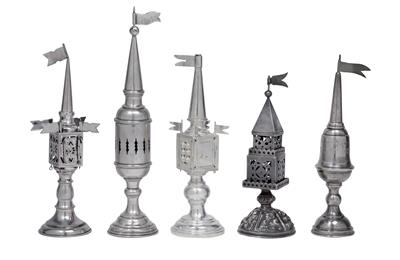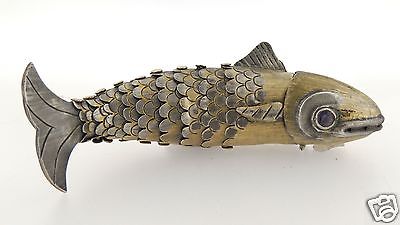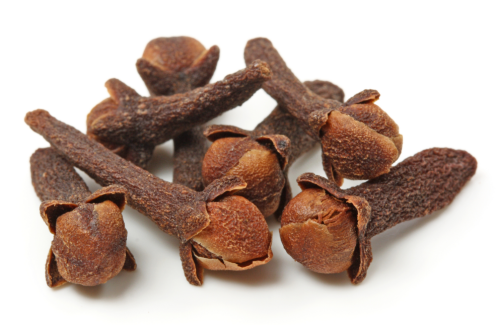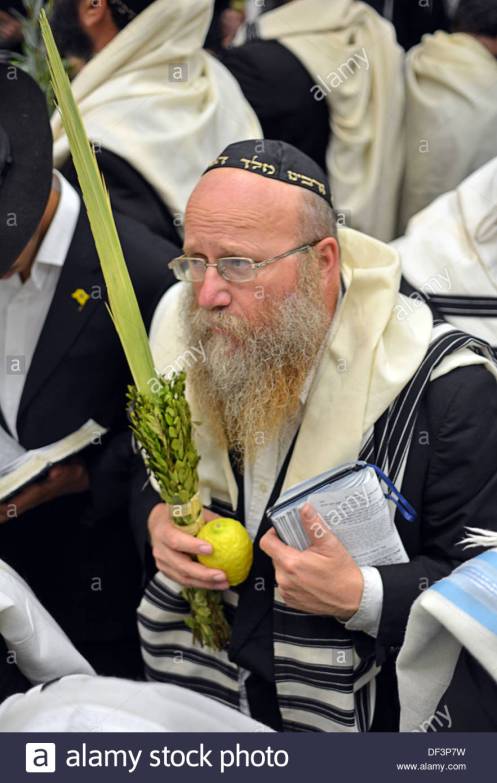Mach was — Gewürze — better late than never?
I had Herba’s response to this theme, more or less. This is not a very spice-friendly part of the world (apart from pickling spices) and in fact, if I have lunch in one of the two Indian restaurants “in town,” when I come back, Dad tells me I smell weird. This week I made a variation of this at home and he was really annoyed about the lingering smell in the kitchen (you have to fry a curry paste, and it takes a while for that smell to go away, even if you use the oven exhaust fan, plus the house is closed up pretty tight just now because of the weather).
But this morning, as the topic closed, a possible blog post hit me.
Spices are important in the lives of observant Jews. That writing about this didn’t occur to me earlier probably is an indication of how far I am from observance at the moment; I haven’t done this ritual in approximately a year, now. The end of every Sabbath is closed with a ceremony called Havdalah (“separation”) that inaugurates the beginning of the week. Prosaically speaking, after Havdalah all the Sabbath prohibitions end and you can turn on the lights, cut things, play musical instruments, cook, spend money, etc. Spices are an essential part of this ceremony.
First, a bit about Havdalah. One can make Havdalah as soon as three stars are visible in the night sky. If it’s overcast or you live in an area with light pollution, there is a calendar of halachic times when you *should* be able to see three stars, which can be consulted to obtain the right time. (In the U.S., it’s always an hour and ten minutes after the latest time permissible to light the candles the previous evening.) Although you can light them earlier if you’re ready to obey the laws of the Sabbath, the latest acceptable candle lighting to begin Shabbat is 18 minutes before sunset (if you miss the time, too bad, you didn’t fulfill the mitzvah and you have delayed the coming of the Messiah). In contrast, it is acceptable to postpone Havdalah to prolong the Sabbath and a lot of people eat a third meal in the late afternoon of the Sabbath (Seudat Shlishit) and do this, if only to put off doing the mountain of dishes. Sabbath prohibitions incidentally explain why it’s still unusual to have a Jewish wedding on Friday or Saturday night, because we’re not allowed to make contracts on the Sabbath and even if most people are not that observant, the custom has stuck.
OK, anyway. So in order to be able to resume the activities of daily life, all one has to do immediately is say the prayer: “Blessed is the one Who divides between the sacred and the mundane.” However, one still has to perform the ceremony before one eats dinner.
I promise I’m getting to the spices, soon.
To perform the ceremony, you fill the cup that usually use to bless wine (kiddush cup) all the way to the top, so that it drips quite a bit onto the plate you have set it on. Then you need a special braided candle — easily found in the kosher section of U.S. supermarkets; we can even get these here in the not-even-Diaspora — which you light and give to someone to hold.
You pick up the wine glass and say the blessing over wine without drinking; then you pick up — wait for it: the spices! smell them, and say the blessing over the spices. You then say the blessing over fire (note: not the same as the candle blessing). You hold your fingers up to the flame, close enough to feel the heat, and then look at them for a moment. You then say a prayer:
Blessed are You, God, King of the Universe, who makes a distinction between sacred and mundane, between light and darkness, between Israel and the nations, between the seventh day and the six working days. Blessed are you, God, Who makes a distinction between sacred and mundane.
Finally, you take two swallows of the wine, then pour some out onto the plate and extinguish the candle in the wine. Some people then put their finger in the wine and dab a little onto their eyelids as a reminder of Psalm 19 (“the law of the Lord is perfect, enlightening the eyes”). Then it’s customary to sing the song that asks for the speedy coming of the prophet Elijah (who will precede the Messiah): אֵלִיָהוּ הַנָבִיא.
All of the prayers can be sung. Here, from about 0:55, is some vid of a Reform congregation performing the ceremony. This fulfillment of the mitzvot would be acceptable from the Orthodox perspective except that they are singing in a mixed gender group and are playing guitars. But I picked this vid because it’s the Havdalah melody that I am most familiar with.
And here’s the most traditional version of אֵלִיָהוּ הַנָבִיא:
So, back to the spices. According to the rabbis, the point of the ritual aspect of Havdalah is that all five senses are involved (you see, smell, taste, hear and feel the end of the Sabbath). The spices are particularly important because in Judaism, smell is said to be the highest or most spiritual of the senses. On the Sabbath, every Jew gains a special extra “Sabbath soul” that disappears after Havdalah. So the spices are used to rejuvenate and cheer up the now-lonely “everyday” soul.
Most Ashkenazic families use cloves for this purpose, although this is not a requirement; one can use any sweet or aromatic, pleasant-smelling natural substance (not bathroom freshener). Often, the spices are kept in a special spice container called a besamim. These decorative boxes are usually made of silver or silver-plate.

A common design for a besamim: a castle form with a flag on top. These were particularly popular in various parts of the Austro-Hungarian Empire and it’s one of the most common designs one sees. Nowadays the flag may take on some sign that it is the Israel flag, but that was not the original custom.
The castle / turret design was supposed to indicate something about the nature of the world to come. The tops of these twist off and you insert the cloves. But there’s no rule about the design other than that you need to be able to smell the spices.
Jews from a German (yekke) family might still have one that looks like this:

This is a modern copy of the fish-form besamim, made in Taxco, México (a region famous for its silver work). Not many of these fishy besamim survived the Holocaust and they are frequently counterfeited.
The fish besamim appeared among the same populations that traditionally ate a fish or the head of a fish on Rosh Hashanah, with the blessing “may G-d make us the head and not the tail,” that is, it’s supposed to be lucky. The mouth or head opens up and you can put the spices in there.
So, I never had a metal besamim, for two reasons. One was that this ritual was often something I did at someone else’s house who had the equipment, and in a pinch, you don’t have to have the metal object. You can take a bottle of cinnamon out of your spice cupboard, open it, smell the spice, and fulfill the mitzvah. However, at times when I did have access to a besamim at home, it was because I made my own. When I was in graduate school I spent a fair amount of time hanging out with Jews whom I used to call the “Jewish Encyclopedia” crowd — these were books published in the 60s and 70s trying to re-animate Jewish traditional ritual practices for an unobservant crowd, and they were very into do-it-yourself.
So how they made a besamim was they punctured an etrog with cloves to make a pomander. Totally clear, right?

This is an etrog. We call this a “citron” in English but I don’t know that I’ve ever seen one in a normal supermarket. (This one is from Italy.) You can buy them from a Jewish greengrocer during Sukkoth, or order one specially through your synagogue. Supposedly, eating jam made from it is considered lucky but I’ve never done that, either.
An etrog is a citrus fruit that is required for fulfilling the commandments on Sukkot (which I haven’t talked about much because it’s not one of those hugely important holidays in my life). It’s one of the four species that one is required to touch and pray with during that holiday.
So back in the days when I was dating The Physicist, he would buy or borrow an etrog and lulav in order to be able to fulfill the mitzvot, and then afterwards, we would make a pomander out of the etrog for the purpose of using it as a besamim. I use the term “we” loosely. He had read Blu Greenberg’s book on traditional Jewish households and thought it was a good idea (it was not something he grew up with) and I executed. And it is a serious pain in the ass. I liked the idea of doing it much more than doing it — it took several evenings of concentrated work because the skin of the etrog is really thick and tough. You have to pierce it with a nail before you put the clove in, but you have to be careful not to pierce it too much or you let the aroma out. And the cloves break all the time.
Here are the directions. And this is what it looks like:
Supposedly they last forever but I wouldn’t know.
Anyway, so that’s what I have to say about spices. Shabbat Shalom a day in advance — and may the Messiah come speedily in our days although I haven’t been lighting candles lately.








I chuckled aloud when you mentioned your area not being particularly steeped in spices or spice lore. I lived in North Dakota for several years, and I had a good friend there who had spent her youth in France and Belgium, and then moved from there to Norway (the “old country” for many North Dakotans). She told me she used to get frustrated at Norwegian cuisine and its comparative (to France, anyway) aversion to spices…but that moving to North Dakota, and its Americanized versions of the Scandinavian cuisine she already found bland, just drove her off the deep end. She used to say, “I mean, these people are afraid of PEPPER!” I still think of her whenever I eat anything aromatic or spicy, or when I encounter things like lefse or gravlax.
Thank you for sharing this, and for your insights on spices. I think spices are utterly fascinating in terms of their role in human history and cultures—we tend to take them for granted in modern society (particulary in mainstream America), but they are anything but ordinary.
Good Shabbos (a day in advance).
LikeLike
Yeah, it’s like they came here and couldn’t afford any spices for the first three generations and forgot all about them. I made a cauliflower soup a few weeks ago and put fresh ground nutmeg on it (which is a pretty standard choice in Germany) and dad was incensed.
Spices are fascinating — they play a really important motivating role in history.
Thanks for the good wishes 🙂
LikeLike
Thanks for the participation, what an interesting read!
LikeLike
Sorry it only occurred to me yesterday. LOL.
LikeLike
No worries!!! Pö and I are really relaxed when it comes to the deadline for our #Machwas! 🙂
LikeLike
[…] hat hier etwas zum Thema Gewürze und Sabbat […]
LikeLike
Interesting read.
Spices used to be such a luxury in Germany – rich merchants were called Pfeffersäcke because pepper was so expensive – and nowadays are all too often taken for granted.
But even then, compared to us I always find it amazing what people in the Far East can do with spices – what a treat a good Indian meal is, for example.
LikeLike
My impression of Germans is that with a few exceptions (Lebkuchen), they tend not to like spice combinations. Lots of nutmeg is great on cauliflower, but only nutmeg.
And I agree, there’s nothing like an Indian meal. Or Thai, for that matter.
LikeLike
I have never heard of nutmeg on cauliflower. The only time we use nutmeg is on eggnog, rice pudding and custard. Can you use it on mashed, or only florets of cauliflower? I really enjoyed your post. Very educational and (of course) fun to read.
LikeLike
I would think you could put it on any variation — perhaps some of our German friends want to weigh in. I have had it on a sliced steamed head of cauliflower (where you clean the cauliflower and steam it whole) with lemon juice and salt; in cauliflower baked with white sauce; and on cauliflower soup with carrots and parsley, etc. The Germans of my personal acquaintance tend to prefer fresh ground nutmeg (you get the spice in the form of a nut and there’s a teeny little grater that goes with it). Warning, though, it did not get my “dad’s seal of approval.”
LikeLike
Well,you have never accused your dad of being a gourmet. If I don’t want to invest on the little grater, would it be horrible to use the nutmeg already ground up and in a tin? I must admit the can I have is probably few years old.
LikeLike
I think it tastes the same, probably it’s like pepper. More intense if freshly ground. You could probably toast it slightly to reanimate it.
LikeLike
My grandmother uses nutmeg for every sort of cabbage and to flavor mashed potatoes
LikeLike
it’s good on brussels sprouts (Rosenkohl) as well, although that’s not my favorite preparation.
LikeLiked by 1 person
Trois usages bien connus en France pour Eugenia Caryophyllus, le clou de girofle:
– La “pomme d’ambre” en été, c’est une orange piquée de clous de girofle qui embaume la maison, chasse les mites et décore magnifiquement,
– Le classique “pot-au-feu” en hiver, c’est une soupe avec du boeuf, 1 os à moelle, des carottes, du poireau, une branche de céleri, une gousse d’ail, un bouquet garni et des oignons piqués de clous de girofle. A vos fourneaux. Bon appétit!
– L’huile essentielle de giroflier dans les soins dentaires, avec précautions pour éviter la causticité dermatologique et la toxicité neurologique.
Pour résumer il y a le parfum, le goût dégagés par cet épice et les propriétés pharmacologiques. (L’ eugénol est antiseptique, antibactérien, antifongique, analgésique, anesthésiant. En Egypte il a été trouvé un sarcophage dont la momie avait un collier de clous de girofle).
Merci pour partager vos coutumes religieuses, bonne fin de semaine en famille.
LikeLike
Pot au feu! Yum!!!! Hope you have a good weekend, too.
LikeLike
Interesting read, thanks! (btw, I had indian last night. My tip for getting rid of the smell, some cheap white vinegar in a bowl + boiling water works nicely as a deodorizer)
LikeLike
What did you have?
LikeLike
Thanks for this. A very interesting and engaging read.
You can imagine that I’m rather fond of spices, myself.
My other half comes from a country that uses them rather sparingly. The first time I made him some eggs all those years ago, he complained about the amount of pepper in it. I’m happy to say that I’ve managed to influence his palate, to the point where he finds his country’s cuisine bland.
What’s life without a little spice? 🙂
LikeLike
I’m glad you managed to move onward in your relationship with your other half. The pepper wars are real, here, too (we have two pepper receptacles — an old style shaker filled with the tasteless kind, for dad, and a pepper mill that cracks it freshly, for me).
I was just reading this article in The Guardian about the rise and fall of UK curry houses and thinking back to my first encounter with Indian cuisine (while visiting a friend in Cambridge, Massachusetts) and going back to the city where I was in graduate school with the intent to buy an Indian cookbook and finding only ONE in the bookstore (back before you could get anything on Amazon) and it was by Madhur Jaffrey (she was mentioned frequently in this article) and thinking at the time what it was going to cost me to get all those spices!
But I did it. me + palak paneer. It was love at first taste.
So yeah — life w/o a little spice is really … bland 🙂
LikeLike
Spices and Havdalah, of course! Lovely read, bringing back childhood memories for me but also more current family memories (I have a Jewish sister and a Jewish brother). I love singing the song in that first video, although I mostly know it singing the ‘borei pri hagafen’ bit for the wine and then followed by the ‘hamuzim lechem min ha’aretz’ prayer for the bread. And I think my mom has one of those silver besamim somewhere in her house. 🙂
LikeLike
It’s a Debbie Friedman tune — really important composer for late twenteith-century Reform Judaism. I really like that melody and it has something of the tradition of nigunim (those repeated melodies with nonsense syllables) in it. She’s gradually going out of style but I think that melody will stick around for a while.
LikeLiked by 1 person